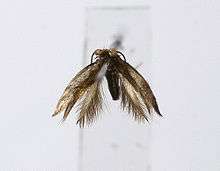Nepticulidae
| Nepticulidae | |
|---|---|
 | |
| Stigmella alnetella | |
| Scientific classification | |
| Kingdom: | Animalia |
| Phylum: | Arthropoda |
| Class: | Insecta |
| Order: | Lepidoptera |
| Suborder: | Glossata |
| Infraorder: | Heteroneura |
| Superfamily: | Nepticuloidea |
| Family: | Nepticulidae |
| Subfamilies and genera | |
|
Pectinivalvinae Nepticulinae | |
| Diversity[1] | |
| About 22 genera and 862 species | |
Nepticulidae is a family of very small moths with a worldwide distribution.[2] They are characterised by eyecaps over the eyes (see also Opostegidae, Bucculatricidae, Lyonetiidae). These pigmy moths or midget moths, as they are commonly known, include the smallest of all living moths, with a wingspan that can be as little as 3 mm. in the case of the European pigmy sorrel moth,[3] but more usually 3.5–10 mm. The wings of adult moths are narrow and lanceolate, sometimes with metallic markings, and with the venation very simplified compared to most other moths.
The minute larvae usually are leaf miners[4] but some species also mine seeds or bark of trees.[5] Much is known about their host plants.[6] The Pectinivalvinae, characterised by a "pectinifer" on the valve of the male genitalia, are endemic to Australia, where they mine the leaves of the tree families Myrtaceae (Scoble, 1983) or Cunoniaceae (Eucryphiaceae), and Elaeocarpaceae (Hoare, 2000). This Australian group probably constitutes the sister group of other pigmy moths (the subfamily Nepticulinae), which is distributed across the world except Antarctica (Davis, 1999). Many species undoubtedly await description and the study of some tropical faunas is just commencing (Puplesis et al., 2002).
Typical nepticulid moth leaf mines referable to the genera Stigmella and Ectoedemia are known from mid-Cretaceous fossils around 97 million years old (Labandeira et al., 1994; Grimaldi and Engel, 2005: 52).
References
- ↑ "Animal biodiversity: An outline of higher-level classification and survey of taxonomic richness - Lepidoptera" (PDF). mapress.com. Retrieved 3 April 2018.
- ↑ Nieukerken, E.J. van et al. 2016: Revised classification and catalogue of global Nepticulidae and Opostegidae (Lepidoptera, Nepticuloidea). ZooKeys, 628: 65-246. doi:10.3897/zookeys.628.9799
- ↑ "Enteucha acetosae - UKMoths". ukmoths.org.uk. Retrieved 3 April 2018.
- ↑ "Nepticulidae". www.leafmines.co.uk. Retrieved 3 April 2018.
- ↑ "Nepticulidae Images @ Insect Images". www.insectimages.org. Retrieved 3 April 2018.
- ↑ "HOSTS - The Hostplants and Caterpillars Database at the Natural History Museum". internt.nhm.ac.uk. Retrieved 3 April 2018.
| Wikispecies has information related to Nepticulidae |
| Wikimedia Commons has media related to Nepticulidae. |
Further reading
- Davis, D.R. (1999). The Monotrysian Heteroneura. Ch. 6, pp. 65–90 in Kristensen, N.P. (Ed.). Lepidoptera, Moths and Butterflies. Volume 1: Evolution, Systematics, and Biogeography. Handbuch der Zoologie. Eine Naturgeschichte der Stämme des Tierreiches / Handbook of Zoology. A Natural History of the phyla of the Animal Kingdom. Band / Volume IV Arthropoda: Insecta Teilband / Part 35: 491 pp. Walter de Gruyter, Berlin, New York.
- Hoare, R.J.B. (2000). A new genus of primitive Nepticulidae (Lepidoptera) from eastern Australia, with a revised diagnosis of nepticulid subfamilies. Zoological Journal of the Linnean Society, 128(3): 289–317.
- Labandeira, C.C., Dilcher, D.L., Davis, D.R. and Wagner, D.L. 1994. Ninety-Seven Million Years of Angiosperm-Insect Association: Paleobiological Insights into the Meaning of Coevolution. Proceedings of the National Academy of Sciences of the United States of America, 91(25): 12278–12282. pdf
- Puplesis, R., Diskus, A., Robinson, G.S. and Onore, G. (2002). A review and checklist of the Neotropical Nepticulidae (Lepidoptera). Bulletin of the Natural History Museum. Entomology Series, 71: 59–76.
- Scoble, M.J. (1983). A revised cladistic classification of the Nepticulidae (Lepidoptera) with descriptions of new taxa mainly from South Africa. Monographs of the Transvaal Museum.
External links
- iNaturalist
- Nepticulidae and Opostegidae of the world
- Tree of Life
- Australian Nepticulidae
- US Leaf mines
- UK leaf mines
- New Zealand species
- Swedish species
- UK species
- Belgian species
- List of available generic names
- Watson, L., and Dallwitz, M.J. 2003 onwards. British insects: the families of Lepidoptera. Version: 29 December 2011 Detailed description and figures including wing venation.